Decandling shohin black pine is similar to decandling larger black pine bonsai with one key difference – it’s done later in the season. Just by a few weeks. By giving summer shoots less time to develop, we prevent them from growing too large. As is often the case in bonsai, proportion is far more important that absolute size. “Small needles” are great in the abstract, but on a tree they can look funny if the proportion is off. Larger trees look good with larger needles, shohin look good with small needles. All of which can be produced by careful decandling.
Here’s a 16 year-old shohin black pine, ready for its second or third decandling. It’s rather shaggy.

Shohin Japanese black pine – before decandling
The first step is sizing up the shoots. As expected, I found large shoots near the top of the tree, and smaller shoots on the lower branches.
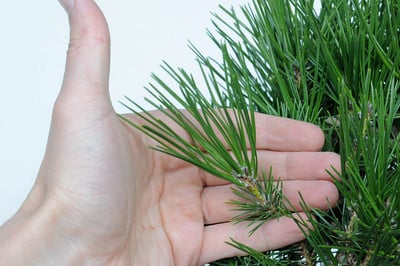
Vigorous shoot

Less-vigorous shoot
For the most part, new shoots were either somewhat large (the two on the left) or fairly small.
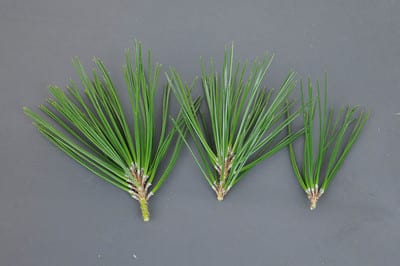
Large, medium-large, and small shoots
Normally I’d like to remove the smallest shoots first, wait 10 days, then remove the larger shoots. But because I decandled this tree a little later than normal this year, I opted to remove all of the spring growth on the same day.
I found, as I worked, several very large shoots.

Two very large shoots with a small shoot for comparison
These were anomales. Each started not near the tree’s apex, but from the center of the tree – the spot where I’d normally expect to find the very weakest shoots. In each case, they sprouted just below large cuts where entire branches were removed the year before. That energy had to go somewhere, and it made it into these shoots.
Because I removed all of the shoots on the same day, I needed a way to slow down the more vigorous areas of the tree to bring the strong and weak areas into balance. To do this, I left stubs – longer in strong areas, shorter in weaker areas – and pulled needles.
Just before getting started, I wondered how I would be able to distinguish the strong areas from the weak after decandling. If I couldn’t tell one from the other, I’d have little guidance when it came time to pull needles. There are two conventional solutions. One is to remove unnecessary needles while decandling, scissors in the left hand, tweezers in the right. This is a great technique – one I would not, however, recommend to anyone without significant pine skills.
For this tree, I opted for the easier alternative – first I cut the spring growth, then I pulled needles. The stubs let me know which shoots were vigorous and which were weak. When I came across a shoot like the one pictured below – large stub, many needles – I’d remove a fair number of needles. When I came across shoots with shorter stubs, I left more needles to help these shoots catch up with their more vigorous neighbors.
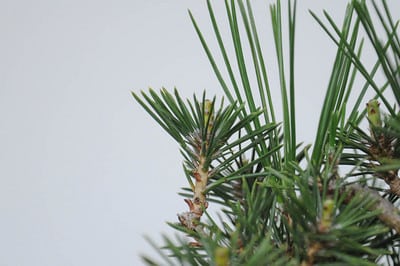
Decandled shoot with stub – before removing needles
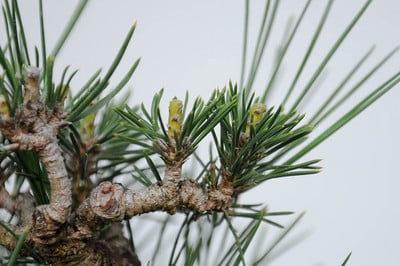
Decandled shoots
Post decandling is a good time to catch up on wiring. In a few weeks, when the new buds appear, wiring becomes very tricky. Once pines get to this point, it’s best to wait until the summer shoots harden off before wiring. Here’s a picture of the tree after removing the spring growth but before thinning the needles.

After removing spring growth.
And here’s a shot of the tree post decandling and needle thinning.
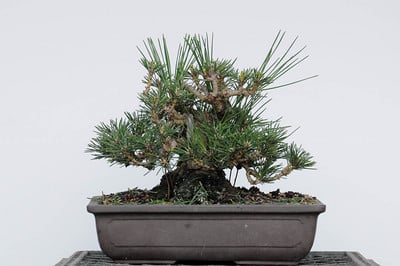
Japanese black pine: decandled, needles thinned
This young tree has a way to go before it’s first exhibit. Once the summer growth comes in, I’ll give the tree a once over – more needle thinning, cutback, and wiring. That will help – I’m optimistic I can show it within the next five years. To better gauge how the tree is coming along, see the following post (my third ever) from a year ago January: Shohin black pine from scratch.
Subscribe to Bonsai Tonight
New Posts Delivered Every Tuesday and Friday
Wayne says
This is a great series with high quality photos and clear explantations. Did you come up with the term ‘decandeling’ for a reason rather than use the more common candle plucking or candle pinching?
xwires says
Hi Wayne – thanks. I’ve actually only heard the technique referred to as “decandling.” I’ve always understood candle pinching to involve breaking candles before they open. Decandling refers to removing the new shoots after they open. I don’t know why the term stuck or from where it comes – it could be a fun project to figure that one out!